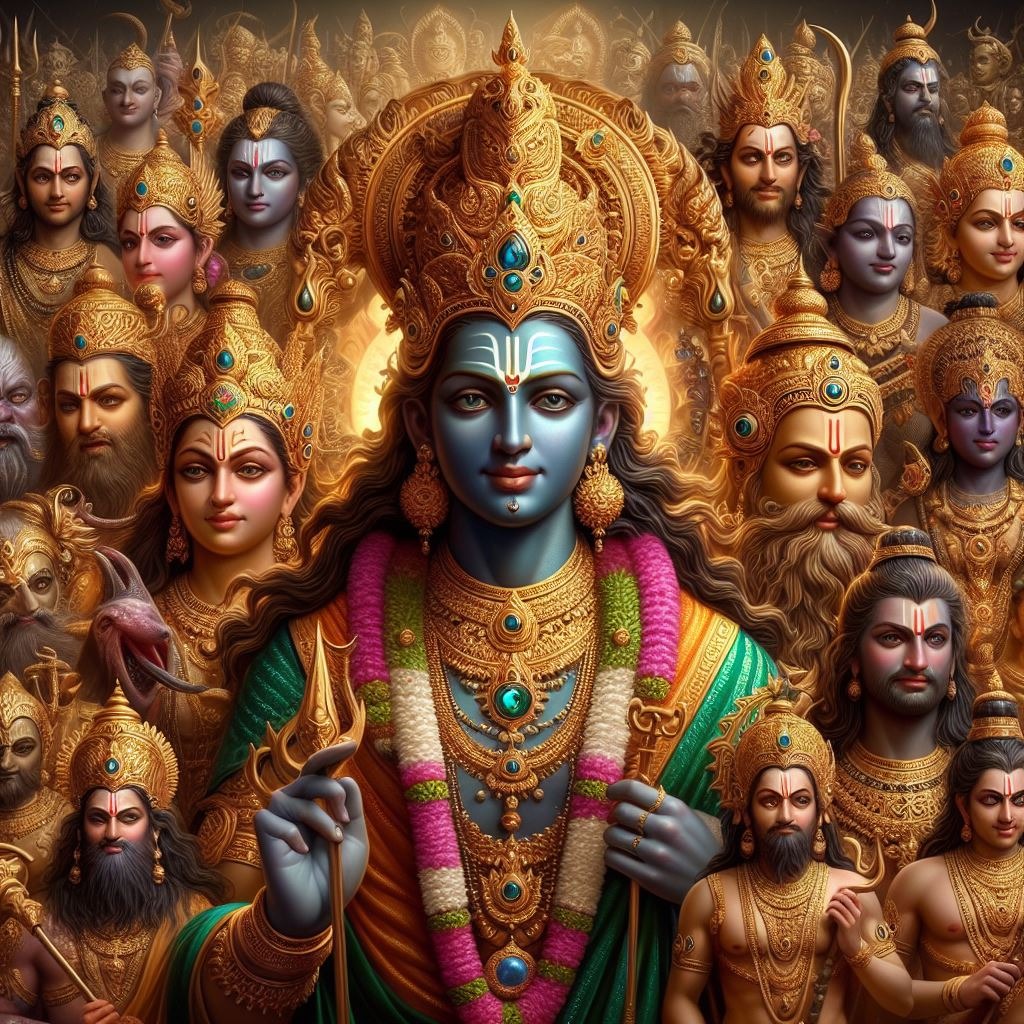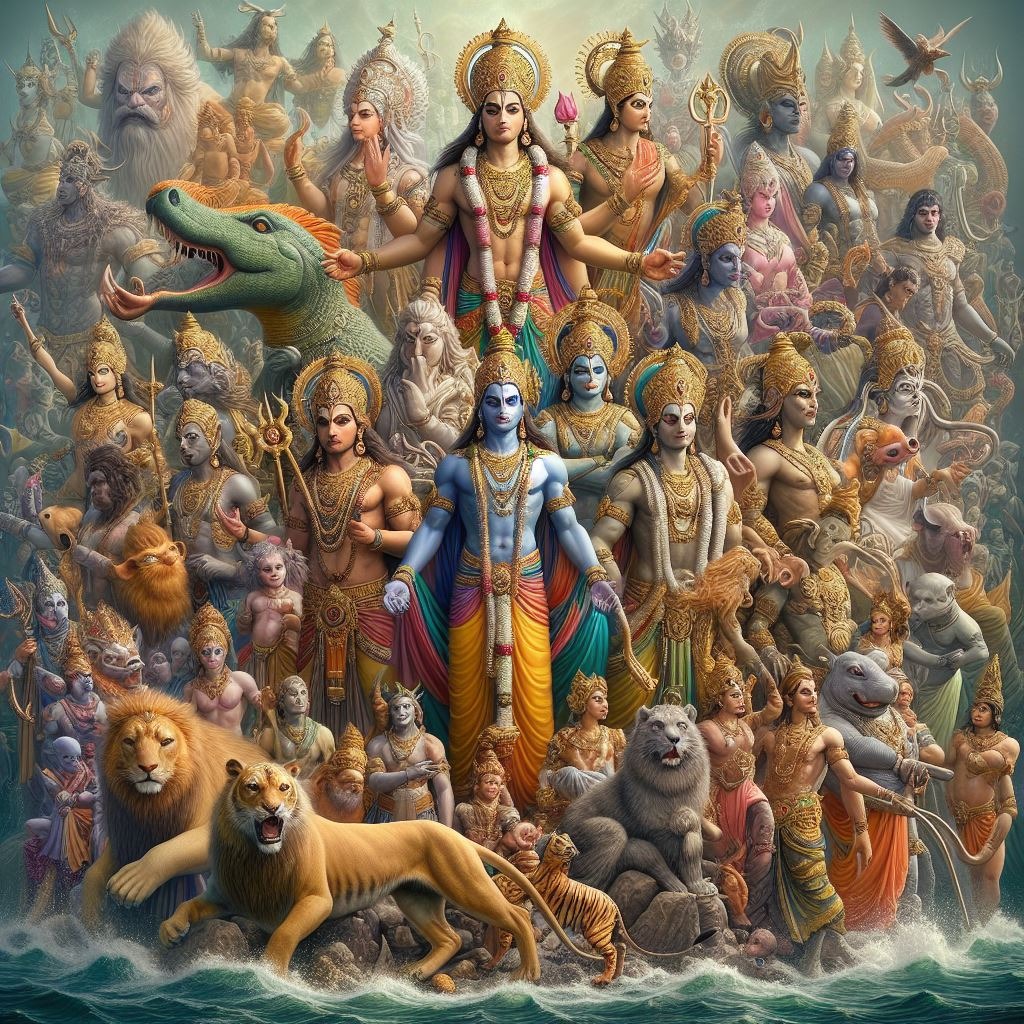Vishnu Avatars, a divine saga intricately woven into the fabric of Hindu mythology. These avatars unfold a cosmic narrative, mirroring the evolution of life on Earth, offering a fascinating parallel to Darwin’s evolutionary theory. The first avatar, Matsya, as a fish, symbolizes life’s emergence from water, akin to Darwin’s concept of aquatic origins. Kurma, the tortoise, signifies the evolution of species spending more time in water. Varaha, the boar, represents life transitioning to land, echoing evolutionary shifts. Vamana, the dwarf, mirrors early humanoid forms, while Parashurama, wielding an axe, symbolizes the industrious phase of humanity. Rama, the epitome of virtue, precedes Krishna, the charismatic and compassionate avatar. This divine journey finds correlation with Darwinian principles, concluding with the prophecy of Kalki, the future avatar, aligning ancient myths with contemporary scientific perspectives. Join us in unraveling the cosmic tapestry of Vishnu Avatars, where spirituality and science converge.
The Known Vishnu Avatars
Matsya Avatar (The Fish Incarnation):
Matsya Avatar, the Fish Incarnation, is a significant and captivating facet of Hindu mythology, featuring prominently in the narrative of Lord Vishnu’s divine incarnations. According to Hindu scriptures, Matsya Avatar emerged during a time when the world faced imminent destruction due to a catastrophic deluge.
The story unfolds with the virtuous sage Manu performing rituals by the river. During these ceremonies, a tiny fish appears, appealing to Manu for protection. Recognizing the divine nature of the fish, Manu agrees and places it in a small vessel. As the fish grows rapidly, Manu transfers it to increasingly larger bodies of water until it reaches the ocean.
Here, Matsya reveals its true identity as Lord Vishnu. In a culmination of events, Matsya saves Manu by providing him with a massive boat, warning him of the impending deluge. The great flood submerges the world, but Matsya ensures the preservation of life by guiding the boat, which contains seeds of all plants and one of each animal species.
Symbolically, Matsya Avatar represents protection, preservation, and the cyclical nature of creation and destruction. The narrative underscores Lord Vishnu’s role as the preserver and protector of dharma (righteousness) in the cosmic order. Matsya’s intervention serves as a pivotal moment in the divine saga of Vishnu Avatars, showcasing the deity’s benevolence and cosmic responsibilities.
Kurma Avatar (The Tortoise Incarnation):
Kurma Avatar, the Tortoise Incarnation, is a revered facet of Hindu mythology and one of the incarnations of Lord Vishnu. This avatar holds deep symbolic significance and is associated with the churning of the cosmic ocean, known as the Samudra Manthan.
The legend unfolds with the Devas (celestial beings) and Asuras (demons) joining forces to churn the ocean in pursuit of the elixir of immortality, known as Amrita. Mount Mandara served as the churning rod, and Vasuki, the serpent, acted as the rope. However, as the churning commenced, the mountain began to sink into the ocean.
To stabilize the situation, Lord Vishnu took the form of Kurma, the Tortoise, and positioned Himself beneath Mount Mandara. With the Tortoise supporting the mountain on its back, the churning continued successfully, leading to the emergence of various divine entities and treasures, including the coveted Amrita.
Kurma Avatar symbolizes stability, support, and the importance of balance in the cosmic order. The tortoise’s unwavering strength and resilience highlight Lord Vishnu’s role as the cosmic preserver. This divine episode also emphasizes the cooperative efforts between the Devas and Asuras, showcasing the cosmic balance achieved through divine intervention.
Kurma Avatar remains a revered symbol, teaching profound lessons about collaboration, stability, and the cyclical nature of creation in Hindu mythology.
Varaha Avatar (The Boar Incarnation):
Varaha Avatar, the Boar Incarnation, is a compelling episode in Hindu mythology that features Lord Vishnu in the form of a boar. This divine incarnation holds significant symbolic and cosmic importance.
The legend of Varaha Avatar unfolds with the demon Hiranyaksha, who, through his great power, submerges the Earth into the cosmic ocean. To rescue the Earth and restore cosmic order, Lord Vishnu incarnates as Varaha. The boar descends into the depths of the cosmic ocean, battles Hiranyaksha, and successfully lifts the Earth on its tusks, bringing it back to its rightful place in the universe.
Varaha Avatar symbolizes the divine intervention required to uphold dharma (righteousness) and restore balance in the cosmos. The boar’s Herculean effort to rescue the Earth reflects the boundless strength and compassion of Lord Vishnu. The tusks lifting the Earth represent the triumph of virtue over evil forces.
This incarnation also carries metaphorical significance, portraying the eternal struggle between good and evil and the cosmic cycles of creation, preservation, and dissolution. Varaha Avatar showcases Lord Vishnu’s unwavering commitment to protecting the universe and maintaining the cosmic order.
Parashurama Avatar (The Warrior with an Axe):
Parashurama Avatar, the Warrior with an Axe, is a dynamic manifestation of Lord Vishnu in Hindu mythology. This avatar is known for its martial prowess and is associated with the revitalization of dharma (righteousness) through the defeat of oppressive forces.
The legend of Parashurama revolves around the Brahmin warrior, Rama Jamadagnya, who becomes Parashurama after receiving an axe (parashu) from Lord Shiva. Driven by a sense of duty and an oath to eradicate the world of corrupt and tyrannical Kshatriya rulers, Parashurama embarks on a relentless mission.
Parashurama engages in a series of battles, showcasing unparalleled skill with the axe. His conquests lead to the cleansing of the Earth from the arrogance and oppression of unjust rulers. The warrior’s commitment to upholding dharma is evident through his unwavering dedication to the cause of justice.
This avatar symbolizes the cyclical nature of divine incarnations, as Parashurama appears in the Treta Yuga, preceding Lord Rama’s incarnation in the subsequent age. Parashurama’s story exemplifies the cosmic principle of balance and the need for periodic divine intervention to restore righteousness.
Parashurama Avatar remains a revered figure, embodying the qualities of valor, duty, and the unyielding commitment to righteousness in the grand tapestry of Vishnu Avatars.
Rama Avatar (The Prince of Ayodhya):
Rama Avatar, known as the Prince of Ayodhya, is one of the most revered incarnations of Lord Vishnu in Hindu mythology. The narrative of Rama Avatar is predominantly depicted in the epic, Ramayana, attributed to the sage Valmiki.
The story begins with the birth of Rama, the eldest son of King Dasharatha of Ayodhya. Rama’s life takes a turn when he is chosen to be the heir to the throne, prompting jealousy in one of the queens, Kaikeyi. Manipulated by her, Dasharatha is compelled to send Rama into exile for fourteen years.
During his exile, Rama, accompanied by his devoted wife Sita and loyal brother Lakshmana, faces numerous trials. The most prominent among them is the abduction of Sita by the demon king Ravana. In an epic battle, Rama, aided by the monkey god Hanuman and an army of monkeys, defeats Ravana and rescues Sita.
The narrative of Rama Avatar is celebrated for its portrayal of virtues such as dharma (righteousness), devotion, and adherence to duty. Rama is revered as the embodiment of virtue, an ideal king, and a devoted husband. His unwavering commitment to truth and righteousness, even in the face of adversity, serves as a moral compass for followers of Hinduism.
The story of Rama Avatar not only highlights the triumph of good over evil but also underscores the timeless values and principles that guide righteous living. Rama remains a symbol of moral uprightness, and his life serves as an eternal source of inspiration for millions.
Krishna Avatar (The Divine Cowherd):
Krishna Avatar, known as the Divine Cowherd, is one of the most beloved and celebrated incarnations of Lord Vishnu in Hindu mythology. The life and teachings of Krishna are primarily documented in the epic, Mahabharata, and the Bhagavad Gita.
Krishna’s story begins with his birth in the town of Mathura, where he emerges in divine form to Devaki and Vasudeva. Fearing persecution by the tyrant king Kamsa, the infant Krishna is secretly transported to the village of Gokul, where he is raised as a cowherd by the loving couple, Nanda and Yashoda.
As Krishna grows, his divine exploits, known as leelas, become legendary. He plays the enchanting flute, dances with the milkmaids (gopis) during the divine Ras Leela, and showcases his divine powers by defeating demons like Kaliya and the mighty serpent, Aghasura.
One of the most significant episodes in Krishna’s life is his role in the Mahabharata. He serves as the charioteer for Prince Arjuna in the Kurukshetra War and imparts profound spiritual wisdom in the Bhagavad Gita, emphasizing concepts such as duty (dharma) and devotion.
Krishna Avatar is revered for its multifaceted representation of divinity, encompassing the playful and mischievous child, the compassionate friend, the divine lover, and the wise philosopher. Krishna’s teachings in the Bhagavad Gita continue to guide seekers on the path of righteousness and spiritual enlightenment.
The Divine Cowherd’s life embodies the idea that the divine can manifest in various forms to connect with humanity, offering solace, guidance, and eternal love. Krishna remains a central figure in Hinduism, capturing hearts with his divine leelas and timeless teachings.

The Awaited Vishnu Avatar as Kalki
Kalki Avatar, often referred to as the Future Savior, is a prophesied incarnation of Lord Vishnu in Hinduism. The concept of Kalki Avatar is primarily found in Puranic texts and forms a crucial part of Hindu eschatology, which deals with end-time scenarios and the ultimate destiny of the cosmos.
According to the Puranas, Kalki Avatar is foretold to appear in the future, riding a white horse named Devadatta. Kalki is envisioned as a warrior wielding a sword, destined to bring an end to the current age, known as Kali Yuga, characterized by a decline in righteousness and an increase in darkness and chaos.
The arrival of Kalki is associated with the restoration of dharma (righteousness) and the establishment of a new era, often referred to as Satya Yuga or the Age of Truth. Kalki is prophesied to annihilate the forces of evil, ushering in a period of spiritual enlightenment and virtue.
While the details and timing of Kalki Avatar’s appearance vary across Hindu traditions, the overarching theme remains consistent—a divine savior who will appear in the future to restore balance, defeat the forces of darkness, and initiate a new era of righteousness.
Kalki Avatar holds a significant place in Hindu cosmology, representing hope for a better future and the cyclical nature of time, where divine intervention is anticipated to bring about cosmic renewal and spiritual awakening. The concept of Kalki Avatar reinforces the belief in the eternal cosmic order and the continuous cycle of creation, preservation, and dissolution in Hindu thought.



